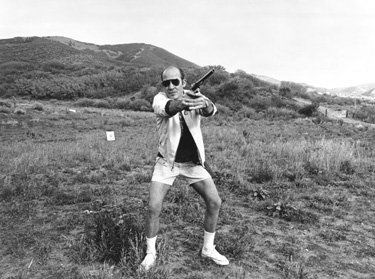Hunter Thompson “Sitting in Hell. Handcuffed to Richard Nixon.”
Bad Behavior, Book Reviews, Gonzo Journalism, Hunter Thompson
Kevin Mims, in Quillette, reviews High White Notes: The Rise and Fall of Gonzo Journalism by David S. Wills with a very amusing account of just how huge an asshole Hunter Thompson really was.
Every few pages of Wills’s book brings another example of Thompson screwing people over. Thompson always had difficulty with self-discipline, but his inability to produce any work was exacerbated by his cocaine abuse. This was certainly bad for his career. But it was also bad for the careers of those in his orbit. Steadman joined Thompson in Zaire where Rolling Stone had sent them to cover the Ali-Foreman fight. Steadman was eager to see the fight, but Thompson told him, “I didn’t come all this way to watch a couple of niggers beat the shit out of each other.” On the morning of the fight, Steadman frantically tried to find Thompson, who had their press passes, but Thompson had sold them and used the money to buy cocaine and marijuana. When Steadman finally found him, he was stoned and was throwing large quantities of marijuana into the hotel pool. …
When the US military began pulling out of Vietnam, Wenner asked Thompson to cover it for Rolling Stone. Thompson agreed but began to lose his nerve as his departure date drew near. Wenner asked New York Times war correspondent Gloria Emerson to try to bolster Thompson’s confidence. The phone calls between them were recorded (Thompson—like Nixon—recorded many of his phone calls and conversations), and Emerson can be heard telling him how to cover the story, passing him the details of her own contacts and translators, and offering to provide him with all the facts about Vietnam that he lacked.
Thompson finally arrived in Vietnam in April of 1975 (more than a decade after the mainstream journalists he hated began covering the story on a daily basis). He took a lot of opium, mingled with prostitutes, and generally behaved like a clown in order to entertain the other journalists, many of whom were fans of his work. But, as Wills remarks, his behavior “wasn’t as funny in real life.” The other journalists quickly realized that his antics might get him—and them—killed. At least 60 Western journalists were killed covering the war and, as Wills points out, “few of them were running around high on drugs.” Tape recordings make it clear that he was hopelessly out of his element. The other journalists can be heard laughing at his ignorance of the facts on the ground. They teased him about the fact that he hadn’t managed to write a word about the Ali-Foreman fight when Norman Mailer had managed to write a groundbreaking piece for Playboy.
Later, by himself, Thompson can be heard spitting out the words, “Fuck them!” on the recorder. At one point, stoned out of his mind and believing he was chasing “four giant fucker pterodactyls,” Thompson wandered dangerously close to the front line. Several journalists had to put themselves in harm’s way to bundle him into a jeep and drive him back to relative safety. … Read the rest of this entry »





